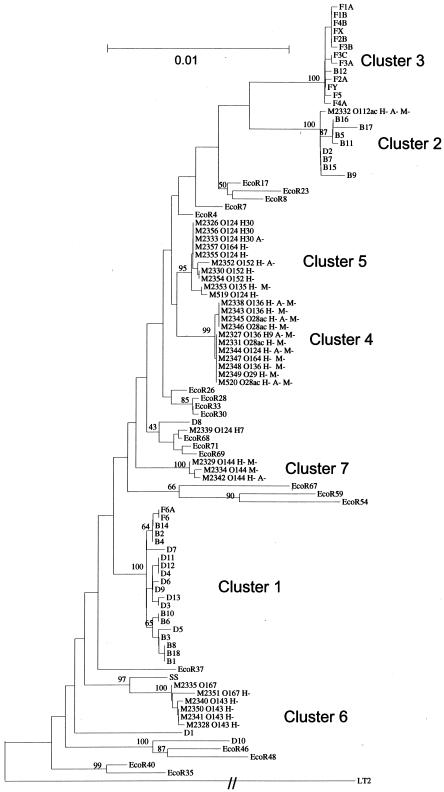One of the lesser known microbiology facts is that the pathogen Shigella is actually E. coli. From the archives, here's an explanation (with a little modification).
As I mentioned in a previous post, Orac has two very good posts on MDs and creationism. In one of the posts, he links to a creationist medical student who writes the following:
Has anyone ever documented a plateful of Strep pneumo mutating into E coli? Or even into Strep pyogenes? I didn't think so. They mutate, and they exchange information. But they remain separate species, with their own unique characteristics. Staph aureus remains unique in possession of the coagulase enzyme; E coli remains identifiable by its lactose metabolism. They are all separate species and geni; and they definitely are not progressing into amoebae or protozoans.
Let's ignore that other species of Staphylococcus also produce the coagulase enzyme. Instead, I'm going to focus on the claim that "E coli remains identifiable by its lactose [milk sugar] metabolism." This is incorrect. There are E. coli that can't metabolize lactose. We call them Shigella (which causes shigellosis, also known as shigellic or bacillary dysentery).
In the lab, Shigella is distinguished from E. coli primarily by its inability to use lactose ("lac-"), along with a couple of other simple biochemical tests. However, when the evolutionary history of Shigella and E. coli is reconstructed using housekeeping genes-genes involved in basic metabolism and cell replication found in all E. coli and Shigella-the Shigella species fall into three distinct lineages within E. coli. Rather than being an offshoot, Shigella is indistinguishable from other E. coli (see the figure below).

(taken from this article).
In the figure, anything with the name "EcoR" is E. coli, and everything else (all the groups called "clusters") are Shigella (at the bottom, LT2 is Salmonella and is the outgroup used to root the phylogenetic tree). You can see that the Shigella are all over. For example, clusters 1 and 6, are nestled in between two E. coli groups (the EcoR 46-48 group and the EcoR 54-59-67 group). This means that these two groups and clusters 1 and 6 are more closely related to each other than other Shigella (such as cluster 4) or other E. coli groups (such as EcoR 26-28-30-33).
So what does this all mean? Each of the Shigella species evolved the ability to cause the same disease symptoms by acquiring the same plasmid (a mini-chromosome that be transferred among bacteria). The Shigella species also 'lost' the same set of functions via convergent evolution: for example, Shigella can not ferment lactose or make cadaverine (apparently, cadaverine inhibits toxins produced by Shigella). However, the three species each lost these abilities in different ways: point mutations, small deletions, or very large deletions of the genes involved.
The reason Shigella is not called E. coli is that Shigella has a very distinct set of disease syndromes, so there is significant medical utility in calling it Shigella (wouldn't want to confuse the MDs, especially since one in particular seems confused enough...). That, in combination with the ease in which Shigella can be identified (it does not ferment lactose, which can be determined by a very simple test) has led to the continuing use of the name Shigella. But there is very little disagreement that Shigella is actually just three separate lineages within E. coli.
So there you have it, Shigella is E. coli even though it 'looks different' since it doesn't metabolize lactose.
An aside: note that I said "very little disagreement", not no disagreement. One group has data that suggest that Shigella and a group of E. coli known as EIEC are descended from a common ancestor. I've looked at the data and reanalyzed it, and I'm not sure I draw the same conclusion (at least one of the genes used recombines so much, I probably wouldn't use it for phylogenetic analysis). However, if this hypothesis is correct, this still poses a problem for creationists, since it would mean that Shigella, which is supposedly a 'different' species, actually arose from E. coli. In addition, we have extant 'intermediates' (the EIEC E. coli), so the creationists can't make the ridiculous 'God of the gaps' arguments that they're so fond of.
An additional note: in re-reading the paper that claims that Shigella and EIEC are related, it appears that Shigella and EIEC are interspersed. In other words, it's the same jumbled up mess that is shown in the figure, but it's confined to one lineage of E. coli, as opposed to occurring throughout the whole species. Either way, Shigella is E. coli.

Mike. You totally rock! Steven J Gould couldna' done it better. Your Geek-Fu is awsome to observe, and read.
The MD ID'er quote is (scarey - and) akin to the usual misobservation that "there are still chimpanzees - so if humans evolved from monkies, why are there still monkies?"
Aaarg!!
I am afraid IDists will argue that the issue has to be interpreted as micro-evolution and put the blame on taxonomist who gave the two strains two different species names.